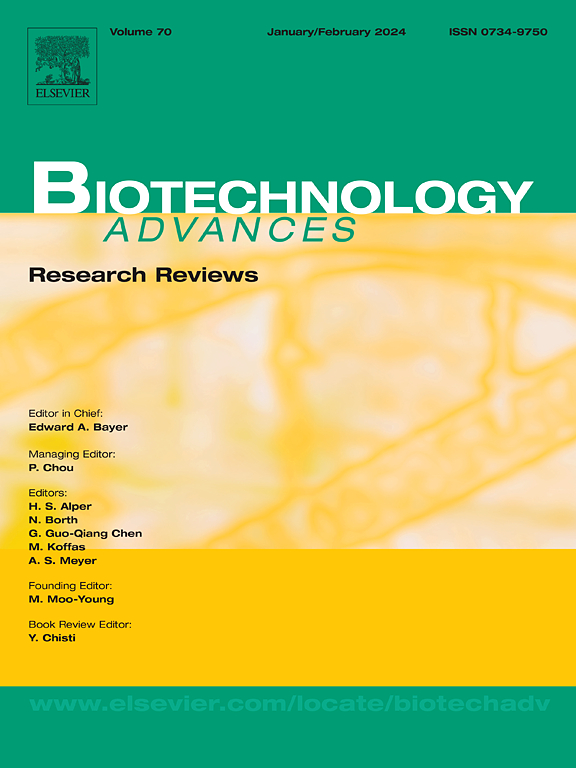Benzylisoquinoline alkaloid production: Moving from crop farming to chemical and biosynthesis
IF 12.5
1区 工程技术
Q1 BIOTECHNOLOGY & APPLIED MICROBIOLOGY
引用次数: 0
Abstract
Benzylisoquinoline alkaloids (BIAs) are a diverse group of plant secondary metabolites that play a key role as analgesics, anti-cancer, and anti-microbial medication. BIAs are currently exclusively produced through crop farming which adversely affects the supply chain resilience of BIA-based medication because availability is limited by low accumulation in plants and harvest seasons. Also, yields fluctuate due to annual weather changes and decrease overall due to global climate change impact on agriculture. Here we review the potential of chemical synthesis, synthetic microbial pathways and genetically engineered plants (cell- and tissue culture) as alternative BIA production approaches. The challenges and opportunities to achieve economically viable BIA titers in the gram per liter range are highlighted. Chemical BIA synthesis is robust and predictable, but yields are often <30% due to the complex chemical structures and the necessary asymmetric synthesis. Synthetic microbial pathways can be engineered into heterologous production hosts like Escherichia coli and Saccharomyces cerevisiae. Whereas the former produces amino acid precursors at high titers, it fails to provide active cytochrome P450 enzymes necessary for BIA synthesis. Yeasts enable the expression of full biosynthetic pathways but struggle with relevant product titers (often <10 mg L-1). Alternatively, genetic engineering can activate the endogenous BIA pathway for a given alkaloid in the native host plant or cell cultures thereof, but currently lacks selectivity of activation and scalability of the processes. Overcoming current barriers to competitiveness will require future research to build upon the works summarized in this review.
苯基异喹啉生物碱生产:从作物种植转向化学和生物合成。
苯基异喹啉生物碱(Benzylisoquinoline alkaloids, BIAs)是一类多样的植物次生代谢物,具有镇痛、抗癌、抗微生物等重要作用。BIAs目前完全通过作物种植生产,这对基于bia的药物的供应链弹性产生不利影响,因为植物和收获季节的低积累限制了可用性。此外,由于每年的天气变化,产量波动,由于全球气候变化对农业的影响,产量总体下降。在这里,我们回顾了化学合成、合成微生物途径和基因工程植物(细胞和组织培养)作为替代BIA生产方法的潜力。强调了在克/升范围内实现经济上可行的BIA滴度的挑战和机遇。化学BIA合成稳健且可预测,但产率通常为-1)。另外,基因工程可以激活原生寄主植物或其细胞培养物中给定生物碱的内源性BIA途径,但目前缺乏激活的选择性和可扩展性。克服当前的竞争力障碍将需要未来的研究建立在本综述中总结的工作基础上。
本文章由计算机程序翻译,如有差异,请以英文原文为准。
求助全文
约1分钟内获得全文
求助全文
来源期刊

Biotechnology advances
工程技术-生物工程与应用微生物
CiteScore
25.50
自引率
2.50%
发文量
167
审稿时长
37 days
期刊介绍:
Biotechnology Advances is a comprehensive review journal that covers all aspects of the multidisciplinary field of biotechnology. The journal focuses on biotechnology principles and their applications in various industries, agriculture, medicine, environmental concerns, and regulatory issues. It publishes authoritative articles that highlight current developments and future trends in the field of biotechnology. The journal invites submissions of manuscripts that are relevant and appropriate. It targets a wide audience, including scientists, engineers, students, instructors, researchers, practitioners, managers, governments, and other stakeholders in the field. Additionally, special issues are published based on selected presentations from recent relevant conferences in collaboration with the organizations hosting those conferences.
 求助内容:
求助内容: 应助结果提醒方式:
应助结果提醒方式:


